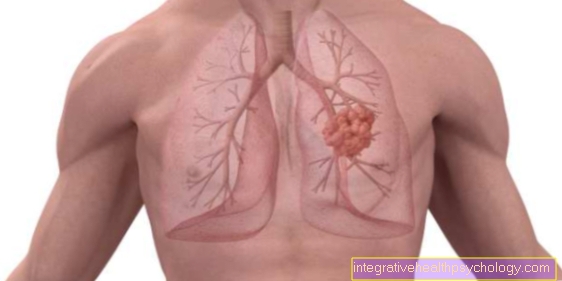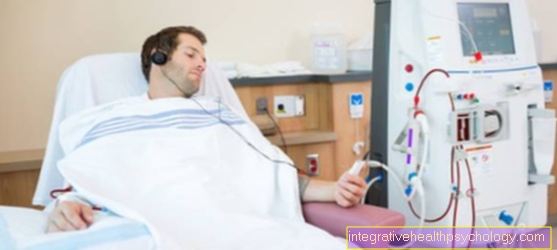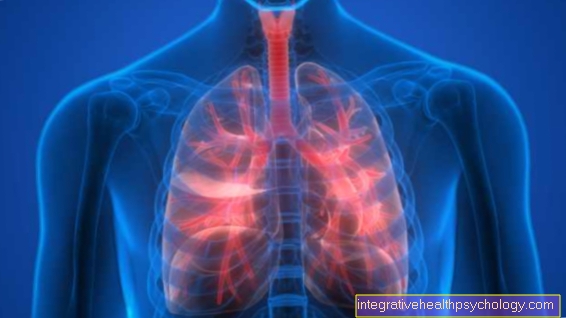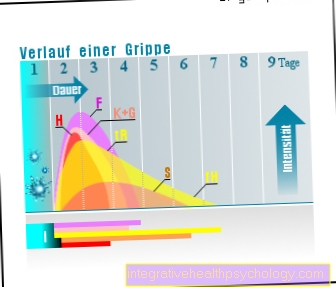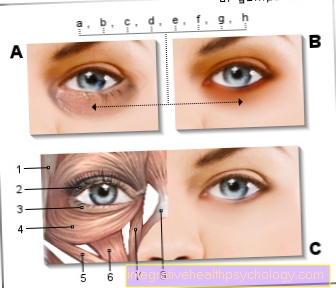Tests to detect appendicitis
introduction
The main symptom of appendicitis is abdominal pain. However, since there are many diseases that cause abdominal pain, some tests are necessary to establish a diagnosis. The first exams are mostly physical. The doctor presses on certain areas in the stomach area, which are usually painful in appendicitis. A blood test can also provide information. Some imaging tests, such as ultrasound, CT, and MRI, can also show an inflamed appendix. However, sometimes the appendix is inflamed without it being visible.

Physical examination
Jump
Hopping creates a lot of movement in the abdominal organs and can make the pain worse in appendicitis. This increase is particularly strong when the appendix lies on a certain muscle, the psoas muscle, as this is tensed during the jumping movement. A person with severe pain, however, will not jump through the emergency room voluntarily, but will lie in a gentle position. Hopping is also a very unspecific sign and not only painful with appendicitis.
McBurney point
If appendicitis is suspected, there are certain points on the body where pressure can cause pain. The McBurney point lies in the middle between the navel and the right, upper bone spine of the pelvic vane. The examiner pushes it in and the affected person feels increased pain with appendicitis and normal position of the appendix.
Lanz point
The Lanz point, like the McBurney point, is one of the typical pain points in appendicitis. A line is drawn between the two upper bone spines of the pelvic blades and this line is divided into three parts. The Lanz point lies between the right and middle third of the line. If you press this point, the pain of the person affected increases if the appendix is in the typical location.
Rovsing symptom
With the Rovsing symptom, the pressure on the appendix is released from within. The examiner strokes the contents of the large intestine against the normal course from the bottom left, over the upper abdomen, down to the right to the appendix. This also increases the pain associated with appendicitis. This test is normally no longer carried out, because if the appendix ruptures, the contents of the intestine are also pressed into the abdomen and the risk of peritonitis increases.
Blumberg sign
The Blumberg sign is also one of the appendix signs. The examiner presses in the lower abdomen on the non-painful side and lets go without warning. In the case of appendicitis, this leads to pain in the right lower abdomen. This is explained by the fact that the abdominal organs move when you let go and thus the inflamed appendix is further irritated. The Blumberg sign also depends on the typical location of the appendix and is not specific to appendicitis.
Sitkowski sign
The Sitkowski's sign is not a pressure point, but a general pain in the right lower abdomen that occurs in the left lateral position. This happens due to the stretching and tensioning of the abdominal wall muscles. Just like all other appendicitis signs, the Sitkowski sign is not specific for appendicitis and can also be positive for other diseases or negative despite the presence of appendicitis.
Psoas sign
The psoas is a muscle that pulls down from the spine to the thighbones. In some people, the appendix lies directly on the muscular surface of the psoas. Therefore, when the muscle is tensed or moved, the pain increases. The doctor can check this by lifting the patient's straight leg in the supine position. Other diseases near the muscle, such as bleeding, can also lead to a positive psoas sign.
Blood test
A blood test is one of the standard tests in hospitals that are carried out on almost every patient. Many different values are tested in the process. Part of the test is to determine the amount of blood cells. There are different types of cells in the blood, such as red blood cells (Erythrocytes), the white blood cells (Leukocytes) and the platelets (Platelets).
The white blood cells are involved in the body's defenses and are increased when there is inflammation. Therefore, increased white blood cell values are to be expected in appendicitis. In addition to this sign of inflammation, there are other values that indicate inflammation in the body. The liver produces a protein called CRP, which is also increased in inflammation. Some other laboratory tests may rule out other possible illnesses or make them more likely. However, a normal laboratory picture does not always mean that there is no appendicitis and, conversely, increased inflammation values only mean inflammation and not necessarily appendicitis. The laboratory results must therefore always be compared with the condition of the person concerned.
Imaging procedures
Ultrasonic
The ultrasound examination is a quickly available examination without side effects and can often also be carried out in general practitioners' practices. The ultrasonic waves are reflected back differently by different organs and substances and thus produce an image. With appendicitis, a large, stiff appendix can be made visible.The wall of the appendix can look like a target with several rings because it is thickened when it is infected. However, the appendix can also be covered by the large intestine so that it is not visible.
CT
Computed tomography is an examination method that works with X-rays. In older and overweight people in particular, an ultrasound examination is often difficult to carry out and CT is a suitable alternative. Other abdominal organs are also clearly visible on the CT, so that other possible causes of pain can also be identified. Similar to ultrasound, the appendix appears as distended and target-like in CT. The radiation exposure is relatively high in CT, which is why it is not the first choice.
MRI
The inflamed appendix is also clearly visible in the MRI. In contrast to CT, MRI does not require radiation exposure and therefore has few side effects. However, an MRI is not available everywhere and even in some hospitals has to be started up in a targeted manner. Those affected are pushed into a tube and have to lie still for a few minutes. This is often not possible with young children. The MRI is not absolutely necessary in most cases of appendicitis. For the protection of unborn babies, the MRI is the method of choice for pregnant women.
Are there special tests for children?
Many diseases are difficult to diagnose in children. Children often cannot say exactly where the pain is localized. Basically, however, the appendix signs also work in children if they are willing to lie down despite the pain. Some tests cannot be done in children. An MRI is often not possible because the children do not lie still. CT has the same problem as MRI. In addition, a CT should be avoided in children in order to reduce radiation exposure. Since these examination options are no longer available, it is necessary to concentrate on the ultrasound and the blood values.
If appendicitis cannot be ruled out, surgery should be given generously. During minimally invasive surgery, the doctor can look at the appendix and decide whether it needs to be removed.
Also read: These are the symptoms I can tell if the child has cervical inflammation





.jpg)




